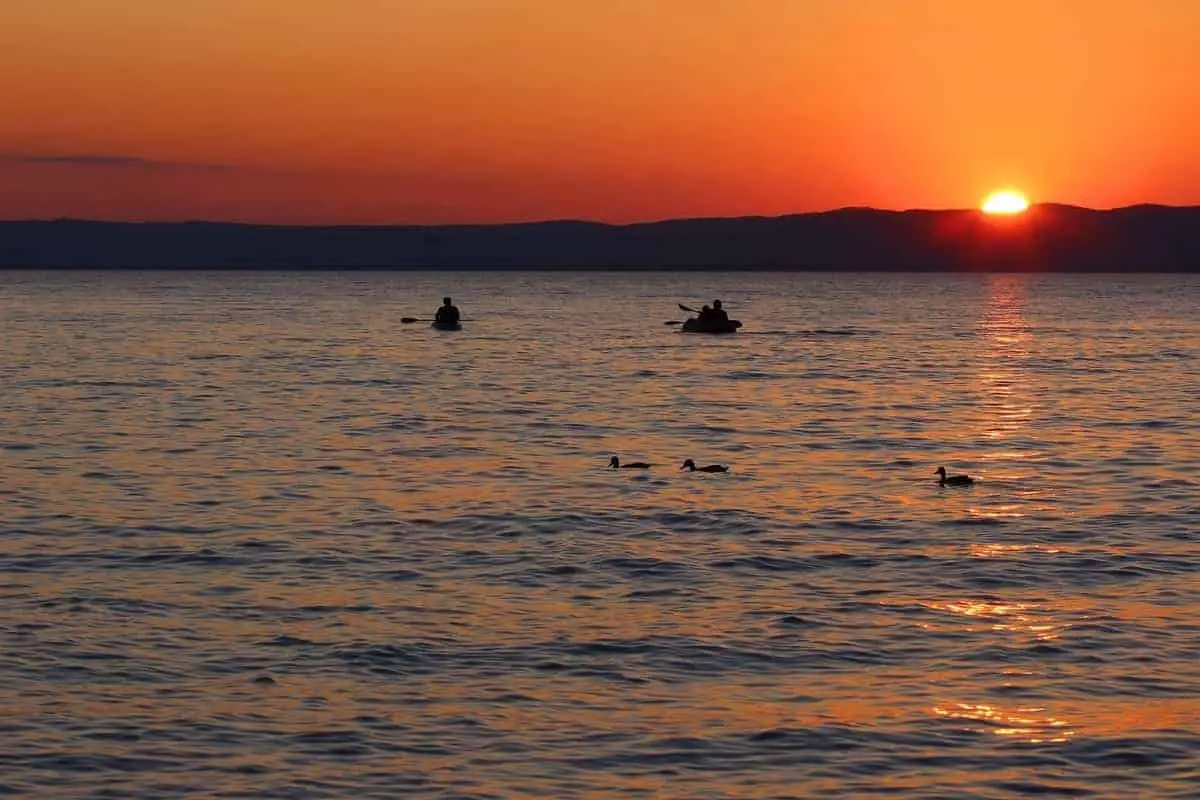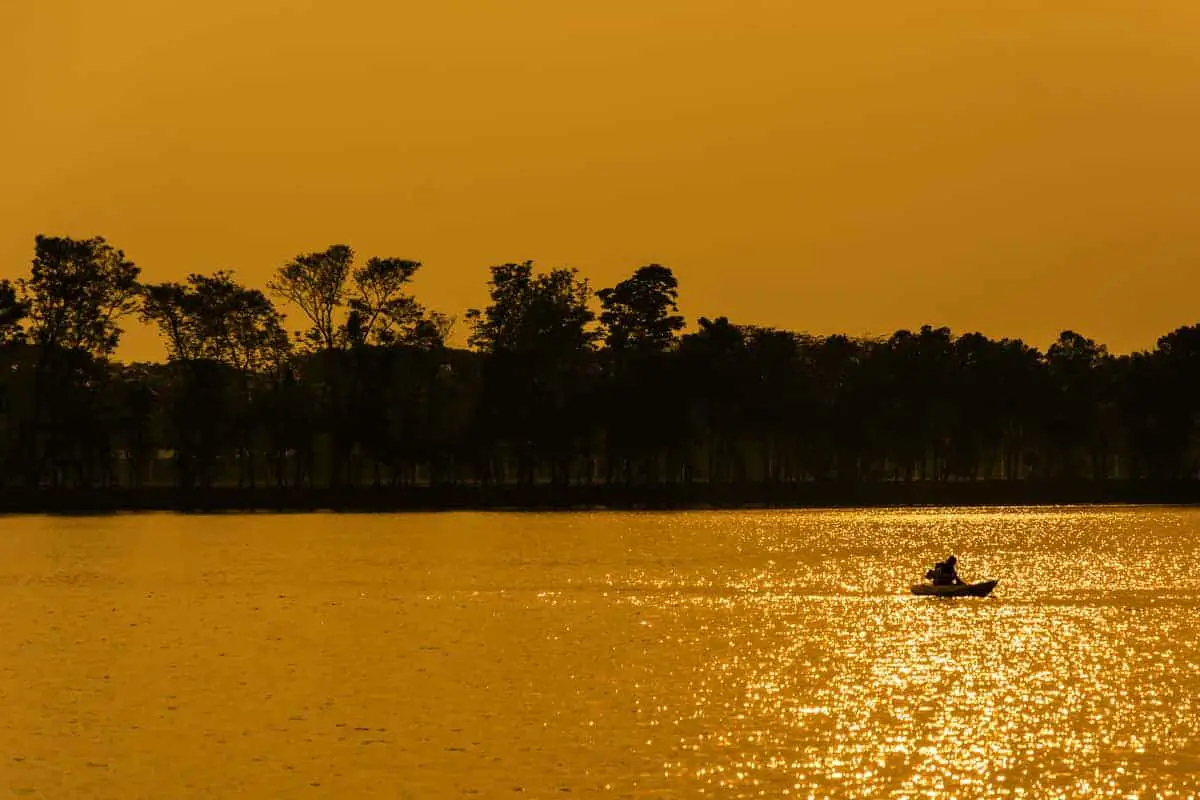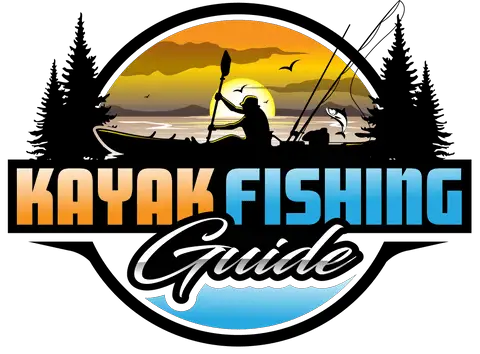This post contains affiliate links.
Kayakers heading back to the shore or launch point as the sun starts to sink low are missing out on some fine fishing opportunities! Whether you are offshore or on a lake, once it gets dark, the whole environment changes.
There are several things you are going to want to do differently when you’re out at night. But the thing to remember when night fishing from a kayak is safety first!
Kayak fishing at night can be done and is some of the best fishing available to kayakers. With proper preparedness, such as safety lighting, wearing a PFD, and a GPS unit to pinpoint your location and return to shore, you’ll target many species of fish that generally aren’t biting during the day.
Depending upon the locale you typically fish, fishing at night is a heck of a lot cooler than during the heat of the day! And you may also have to deal with little boat traffic after dark as well.
If you’ve been daylight kayak fishing for a long time, transitioning to night fishing will take a few adjustments but isn’t very hard either. I’ll go into them down below! You’ll end up wanting to night fish every night!
Must Have Items for Night Fishing in a Kayak
We all have cut corners at times in many areas of our lives, right? Well, kayaking at night isn’t one of those times! Here’s a list of items you must have with you to safely fish at night from your kayak!
- Personal Floatation Device (PFD)
- Kayak Lighting (United States Coast Guard Approved)
- Handheld GPS or GPS Equipped Fish Finder
- Flashlight/Headlamp
- Water Safety Knife
- Waterproof VHF Radio
- First Aid Kit
- Safety Whistle/Air Horn
- Paddle Leash/Paddle Clip
- Fish Grips
- Hook Remover
- Long Sleeve Shirt/Jacket
- Cell Phone
- Food and Water

You should have many items above with you when you are kayaking. And I’ve seen many out on the water during the day without a PFD and other things!
So for some of you, it’s second nature, and for others, you should have at least half of the items with you during the day!
We have all slid our yak into the water and weren’t wearing a PFD 100% of the time. Or we had heavy boots on that would make it almost impossible to get back into the kayak if it flipped.
Personal Floatation Device (PFD)
If you’re not wearing a Coast Guard Approved Floatation Device well, you should be! It’s required by law, and if you’re planning on kayak fishing at night, you should 100% be wearing one.
Related article: NRS Chinook Vs. Stohlquist Fisherman: Which PFD Is Better?
I wear the NRS Chinook Fishing PFD, but this is a personal choice, and I do have a Recommended Gear Page comparing the top three PFD’s if you want to check those out.
Kayak Lighting (United States Coast Guard Approved)
When you’re out on the water after dark, especially high boating traffic areas, it is imperative others can readily see you! If you happen to be fishing on private property with no other boating traffic, you can probably get away without one.
Related Article: Nighttime Kayaking: Light Requirements Explained
When I was first married, my in-laws had a beautiful eight-acre lake tucked away on their forty-acre property in southeast Kansas. None of us boys had lights when we night fished!
Handheld GPS or GPS Equipped Fish Finder
There have been a few times I became turned around, and if it wasn’t for my GPS, and many years ago, a compass, I would have been out all night until after the sun came up!
I do not kayak offshore, living here in Wyoming to drift miles away from my launching point after dark. If you fish in huge reservoirs or offshore, then a handheld GPS unit can be a lifesaver!
Many of the new electronic fish finders have GPG capabilities built within too. So there really isn’t any reason not to have one since basic eTrex GPS units are well within reach for most anglers!
Flashlight/Headlamp
Having a good flashlight on hand with extra batteries will come in handy on and off the water! Better yet, a good headlamp will give you hands-free operation to land fish and to swap lures or baits!
I carry a couple of Petzl headlamps and keep one in my truck at all times, along with at least one in the kayak. Never count on just one flashlight or headlamp while you’re on the water!
Water Safety Knife
Becoming entangled in fishing or anchor lines commands a quick reaction. Always be ready to cut yourself loose with a water safety knife when the situation arises!
During the daylight hours, rope and line management are relatively easy since you can see where knots or tangles are. After dark, even with a headlamp, you may not be able to spot them quick enough!
Related Article: Best Kayak Fishing Safety Knife? (My #1 Pick) I field test four of the top-rated knives!
When time is short, and your anchor gets caught up in structure on the bottom, have your water safety knife lashed to your PFD where you can immediately reach it!
Waterproof VHF Radio
Typically where I fish, I’m never far from shore when on a mountain lake or have pleasure boaters and jet-skis not far away on our local lakes. I have used two-way radios to stay in contact with a fishing buddy when we’ve gone our separate ways.
When fishing offshore and for the larger fish species, having a good-quality communication device is as important as wearing your PFD! The Uniden MHS75 waterproof VHF radio is a reasonable and popular model.
If your pedal mechanism breaks, you lose your paddle, or you have a health issue, among other emergencies, it is a good practice to have communication at night (or daytime too!) with those who could respond.
First Aid Kit
One should carry a good first aid kit as well, no matter what time of the day or night you hit the water. There are plenty of good ones to choose from, and your local Cabelas, Bass Pro, or Sportsman’s Warehouse should have a variety of kits to choose from.
Safety Whistle/Air Horn
To attract attention, should you need it, a safety whistle or air horn can do that for you. They are inexpensive and take up very little room in your kayak.
A small plastic whistle can easily be attached to a D-ring or lashing point on your PFD (next to your safety knife!).
Paddle Leash/Paddle Clip
If you don’t have a paddle leash on your paddle, and I see quite a few kayakers without one, a paddle leash will save you many times over for the cost of one!
If you’ve never had one, you can get the economical paddle Leash with a 2 rod leash set, plus 1 carabiner from Amazon, and it’s a great deal.
Fish Grips
Handling a large or toothy fish at night and having them flopping around in your kayak isn’t the best thing to happen in the dark! Fish Grips that float are a handy thing to have with you!
Once you have your fish next to your kayak, clip it with the fish grips (attach it to your seat or rod holders with one of the extra leashes above!), and it won’t be going anywhere until you’re ready to release or dispatch it!
Hook Remover
When hooked deeply, or the fish begins to thrash around, using a hook remover instead of your fingers is a smart practice. Ever had a treble hook buried deep in your thumb or finger? Ouch!
For years I never carried a good hook remover until after I had a bass with a 3/4 oz jig stuck deep within its throat. I thought she was played out and quiet until my hand was way in there, and she woke up!
Luckily I was on a buddy’s bass boat, and he cut the hook at the barb, and we backed it out. Had I been on a kayak in the dark by myself, it would have been a whole different story!

Long Sleeve Shirt/Jacket
Temperatures have a way of dropping after the sun goes down. When there is a breeze blowing across the water the humidity can make it feel cooler than it really is too.
Roll up a long sleeve UPF shirt or light jacket and use a small dry bag or storage to have it with you if you need it. You’ll have a better time on the water when you’re comfortable.
Cell Phone
Keep your cell phone in an inexpensive ziplock baggie to protect it from water damage. There are floatable waterproof cases you can purchase to carry them as well.
Everyone seems to own a cell phone, but there are areas where you won’t receive a good signal if you need assistance. So consider having a two-way VHF radio with you as well!
Always have a good charge on your cell phone, and you may even want to carry an extra charger bank in case the battery gets low!
Food and Water
You’d be surprised how dehydrated one can get while on the water! Moreso, if you have been fishing and paddling about during the afternoon and have decided to fish after dark.
Bring along plenty of water to drink and maybe a few drinks like Gatorade or Powerade to replenish your body! Soft drinks and alcohol aren’t the best way to energize your body!
Have snacks and food with you too! Beef jerky, fruit or sandwiches are staples among us anglers.
Kayak Night Lights Requirements
As the sunlight fades, you will want to have a kayak safety light attached to your kayak. A light that can readily be seen in a 360-degree arc is preferred.
Related Article: Nighttime Kayaking: Light Requirements Explained
The most concerning time in a kayak when on the water is when the sun begins to go down. Boaters are heading to the launch ramps at crazy speeds, and they are somewhat tired after being on the water most of the day.
This is when they may not notice you and having a lighted kayak will bring more attention to your way!
Paddle-powered kayaks will fall under a different set of rules than the newer electric-powered models. See Rule 25d of the USCG Navigation Center site.
Kayak Fishing at Night – Know Your Direction
One of the best things about kayak fishing at night is the peace and solitude it provides, especially if the stars are out in all their glory! The water slapping against your kayak and a full moon above makes a priceless night!
The one thing I picked up on early to help me while fishing at night is to pick out a landmark near my truck! I am horrible at instinctive direction, and when the stars are behind clouds, I’m at a loss!
If you’re fortunate, you’ll have a blinking red light on the radio or cell phone tower in the distance you can readily see. As dusk begins to sneak up on you, get a good look at that landmark!
You may have a home with a yard light overlooking the lake or shoreline, and if you’re in a bigger city or shoreline, possibly a lighthouse or brightly lit marina to use as a landmark!
Always know the direction you need to head in order to return to your launching point and it’s wise to carry a GPS unit with you!
Can You Catch Fish at Night in a Kayak

Fishing at night is absolutely enjoyable! Many of your smaller fish, like bluegill, will head to protected areas for the night to hide from predator fish. I have hooked into many nice bass while throwing topwater baits after dark!
The advantage of using a topwater bait is you can hear it gurgle on its way back to you. And there is enough illumination on the water, you’ll very often see the wake it makes!
Large flathead catfish ranging between 40 to 50lbs are caught after dark most of the time when on a river or large reservoir. Back home, we would use bluegills or bullheads as live bait to entice those large cats out!
There were waters in Kansas where you could use a topwater Jitterbug bait, in a shallow bay, where channel cats would destroy the bait!
Can Fish See Lures at Night
Fish have lateral lines that pick up vibrations in the water so they “see” in a different way after dark. If you’re an offshore guy, many fish species can also sense blood in the water too!
Using a heavy vibrating lure will bring in more fish than a quiet lure at night. I like to use topwater baits and believe fish can not only sense the bait wobbling across the surface and they also pick up its silhouette.
A heavy-thumping spinnerbait is also a great choice to toss! Fish will hone in on these vibrations and crush those baits!
Taking your kayak out at night to fish is a blast if you’re doing it the proper way and are prepared.
Go and give it a shot and I’m certain you’ll become a huge fan of night fishing!
Have fun and stay safe out there!

